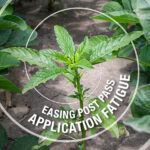Beat Late Blight for Healthier Potato Yields
Water-soaked spots on lower leaves and strong odors are tell-tale signs that there’s potato late blight in the field.

Potato growers are no strangers to late blight, especially in regions like the Northeast, Pacific Northwest and Upper Midwest. Cool, wet weather conditions provide the right environment for the spread of the disease.
Potato late blight can rapidly damage potato crops, starting with the foliage and tubers. Recognizing the symptoms, understanding management strategies and staying updated on available tools and resources can help growers design an effective program for managing late blight.
According to University of Minnesota Extension, late blight symptoms manifest as small, light-to-dark green, circular- or irregularly shaped spots on lower leaves. White, cottony mildew is often visible on infected leaves. Stems, petioles and tubers are also susceptible to the disease.
Additionally, late blight can cause leaves to appear greasy or water-soaked, with a distinct decaying odor in the fields, according to the University of Connecticut College of Agriculture. Upon closer inspection, affected potatoes exhibit a tan to reddish brown dry rot.
Managing late blight starts with removing any previously infected plants and avoiding planting in low-lying, swampy areas. Fungicides that incorporate a novel mode of action without cross-resistance to other fungicides are a critical part of late blight programs. Regular field scouting to detect early signs of infection helps inform timely applications that maximize their impact.
One notable fungicide in late blight management is Orondis® Opti fungicide. Its unique combination of oxathiapiprolin and chlorothalonil helps provide effective protection to potatoes with late blight pressure.
Another option to consider is Orondis Ultra. This includes oxathiapiprolin and mandipropamid, making it a good option for growers whose programs already include fungicides with chlorothalonil.
Kiran Shetty, Ph.D., technical product lead for potatoes at Syngenta, emphasizes the importance of proactive late blight management with vigilant scouting. Shetty underscores the importance of timely fungicide applications to protect yields in the field and surrounding areas.
Hear more from Shetty about the best chemistries to beat late blight:
With proactive measures and access to effective fungicides, vigilant potato growers can beat late blight and safeguard their yield potential.
2 Min Read
- Late blight is a serious concern for potato growers in regions with cool, wet weather conditions.
- Symptoms include water-soaked spots on leaves and a distinct decaying odor in fields.
- Managing late blight involves removing infected plants, scouting and timely applications of effective fungicides like Orondis® Opti or Orondis Ultra.
More Articles About Field Insights
RECOMMENDED FOR YOU
2 Min Read























